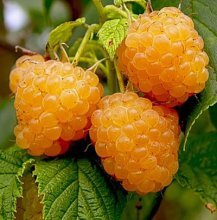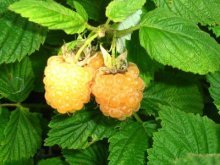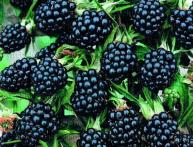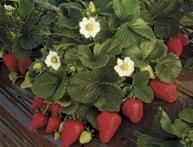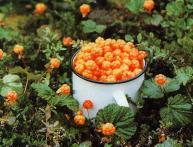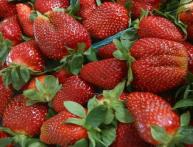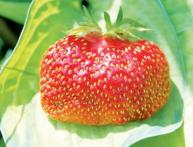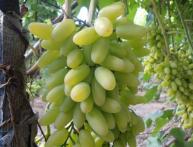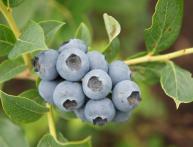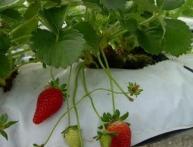Raspberry Yellow giant: advantages and features

Yellow raspberries are still such a rarity in our gardens. And in vain. Unlike red and black varieties, it is suitable for allergy sufferers, young children with an undeveloped immune system, and pregnant women. This is due to the small amount of anthocyanin coloring substances.
In addition, yellow raspberries have more sugar and less organic acids, which makes them sweeter. That's why children like it more than red. Yellow raspberries are indispensable for diabetics who are limited in the range of permitted products due to the nature of the disease.
Content:
- Types of garden raspberries
- The best variety of yellow raspberries
- Planting and growing Yellow Giant raspberries
- Caring for yellow raspberries. Disease and pest control
Types of garden raspberries
Today there are many types of garden raspberries, differing in color, duration and time of fruiting:
- Red. The most common, the largest number of bred varieties of different ripening periods. Regular raspberries, which bear fruit once per season, are harvested in June-July, depending on the variety.
- Remontant raspberry, begins to bear fruit later, from August. Berries appear continuously until frost. It is better to plant different varieties to enjoy the berries throughout the season.
- Black. So far very rare in our gardens. It was bred by American breeders, but the first developments of Russian scientists have already appeared. The fruits are smaller than those of ordinary raspberries and have an unusual taste for this berry.Black raspberries are an excellent remedy for the prevention of cancer.
- Yellow. Due to its sunny appearance, it is often used by landscape designers to decorate the garden. It was developed a long time ago, but was unjustifiably forgotten by gardeners. Usually very large, it gives a bountiful harvest from the bush. All varieties of yellow raspberries are remontant, which makes it possible to enjoy the delicious berries for a long time. Does not handle storage well, but is excellent in preserves.
Each raspberry has its own characteristics that are very useful to humans; it is always worth paying attention to new varieties bred by breeders taking into account the best qualities of the old ones.
The best variety of yellow raspberries
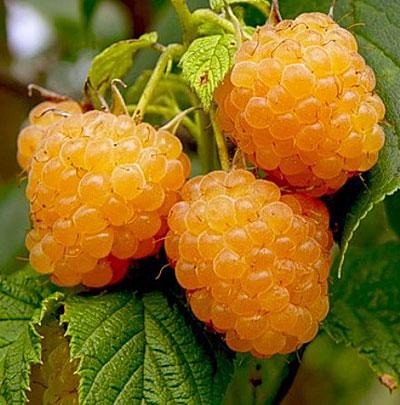
Breeders create new varieties of berries, guided by certain criteria. Some are stored well, others do not fall off the bush, which is very good when the raspberry garden is located in the country, which the owners visit only on weekends. When creating other varieties, the emphasis is on disease or drought resistance.
The Yellow Giant raspberry was created as a table berry suitable for human consumption. Very large, beautiful berries attract with their sunshine and health.
The yellow giant lives up to its name - it reaches a height of more than two meters, which requires gartering to a trellis. Many gardeners use this useful and very beautiful plant to decorate alleys and gazebos. Besides high yield, up to six kilograms per bush, raspberries have excellent winter hardiness and resistance to all kinds of diseases.
The only drawback is that the berry quickly loses its presentation, does not hold its shape during processing and crumbles.You should not refuse such a healthy fruit, guided only by its subjective aesthetic shortcomings.
Planting raspberries Yellow giant
The rules for planting Yellow Giant raspberry seedlings are no different from those generally accepted for red ones. Raspberries can be planted in autumn and spring. But in the fall it is better, because the plant wakes up very early in the spring and begins the growing season, there is a high probability of missing the period allowed for planting.
Although raspberries are a moisture-loving plant, they tolerate excess moisture very poorly. The landing site should be chosen on a hill. It must be well lit by the sun, otherwise the harvest will be small and insignificant.
It is considered the most effective for any raspberry trench planting. Prepare a trench a month before planting. If we take into account that the plant is usually planted in late August - early September, with a slight adjustment for the characteristics of certain climatic zones, then the hole should be ready at the beginning of the last summer month.
Trench dimensions: 50 centimeters in width and depth, the length is arbitrary depending on the number of seedlings. It is better to remove the top fertile layer and put it aside. Fill a third of the dug hole with organic matter, which is so abundant in the autumn garden: fallen leaves, small branches, vegetable remains.
You should not get carried away with fertilizers - compost is enough for raspberries, which is formed over time from the added organic matter and will nourish and warm the plant for a long time. The soil must be returned to the hole in the order in which it was removed - the top layer must return to its place.
To prevent the growing roots of raspberries from starting to occupy areas that are not intended for them, you should fence the trench along the contour with a fence made of slate or old linoleum, deepening it ten centimeters. The raspberry root is located very close to the surface of the earth and this depth is sufficient.
Caring for yellow raspberries. Disease and pest control
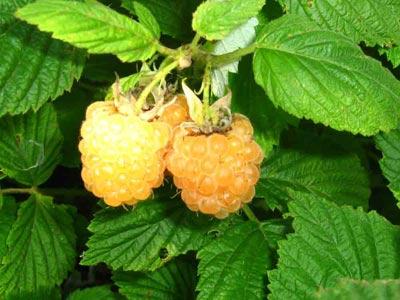
Raspberries are the most undemanding plant. All its care consists of watering and timely harvesting. Like any remontant raspberry, the Yellow Giant develops in one season; in the fall, after harvesting, it should be cut flush to the ground. Fertilizers are applied in the autumn into the rows dug with shovels, and not under the bushes. It is better to apply organic and mineral fertilizers, alternating between years.
Due to the fact that the stems of the Yellow Giant are completely cut off in the fall, many pests that remain to overwinter on the stems and leaves are removed from the area.
Many gardeners do not prune raspberries, but leave their stems for the winter, tied to a trellis. In this case, it will begin to bear fruit in June, but the berries will be much smaller and less juicy.
A big plus in favor of the Yellow Giant is that there is no need to wrap and cover it for the winter, and this requires a lot of time and certain financial costs for covering material. It is enough just to prune it correctly and mulch it with organic matter, which is so abundant in the autumn garden.
For prevention pest infestations For raspberries, autumn pruning, removing fallen leaves and digging the soil is sufficient. During the season, it is necessary to prevent the appearance of weeds in the raspberry field. The yellow giant is resistant to disease.
Disease prevention involves the same measures as against pests.It is worth remembering that some diseases can be caused by cold water for irrigation and dense plantings.
In addition to its beneficial properties, Yellow Giant raspberries have a huge advantage that will soon be appreciated by gardeners. With minimal care, it produces huge yields of magnificent berries.
An experienced gardener about the benefits of the Yellow Giant variety:
Interesting information about the vegetable garden

